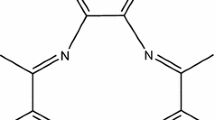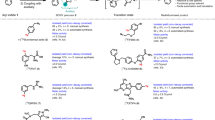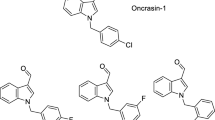Abstract
Meta-iodobenzylguanidine (mIBG) has been radiolabelled at the no-carrier-added level with [124I] for a proof of concept study to assess the diagnostic accuracy of [124I]mIBG PET/CT in detecting metastatic deposits in patients diagnosed with metastatic neuroblastoma. Radiolabelling of mIBG was achieved via the iododesilylation reaction between [124I]sodium iodide and meta-trimethylsilylbenzylguanidine. [124I]mIBG was produced in 62–70 % radioiodide incorporation yield from [124I]sodium iodide. The average amount of formulated [124I]mIBG was 359 MBq (range 344–389 MBq) with an average specific radioactivity of 4.1 TBq μmol−1 (range 1.8–5.9 TBq μmol−1) at end of synthesis.
Similar content being viewed by others
Avoid common mistakes on your manuscript.
Introduction
Radioiodinated meta-iodobenzylguanidine (mIBG) is an analogue of the hormone and neurotransmitter norepinephrine. Its adrenergic uptake, storage and release properties allow its different radiolabelled forms to be clinically used for the radiotherapy and imaging of neuroendocrine tumours and cardiac diseases. Early studies using carrier-added [123I]mIBG with gamma scintigraphy to image normal myocardium function [1] have progressed to single photon emission computed tomography (SPECT) imaging of cardiac and pulmonary abnormalities using no-carrier-added [123I]mIBG [2, 3]. In comparison, limited diagnostic information can be obtained using planar scintigraphy with [131I]mIBG which is also used in radiotherapy to treat neuroendocrine tumours [4]. In contrast, positron emission tomography (PET) with [124I]mIBG [5, 6] is less widely used but has the potential to provide more detailed functional information concerning normal and diseased states of the neuroendocrine system.
Neuroblastoma is a neuroendocrine tumour which presents a significant health issue as the most common extracranial cancer in children. Its high risk form is associated with one of the worst prognoses of all childhood malignancies [6]. In vivo imaging for the accurate staging and measurement of response to therapy is critical to the risk stratification of patients with neuroblastoma in order to offer the most individually tailored treatment possible. Currently used planar [123I]mIBG scintigraphy does however have disadvantages associated with its poor spatial and anatomical resolution [7, 8]. SPECT has been used to provide better comparison with anatomical imaging data, in particular when images are fused with X-ray computed tomography (CT) or a combined SPECT-CT scanner is available. The disadvantages of SPECT are that resolution still remains relatively poor and quantification of uptake is difficult [9]. Additionally, rapid whole-body scanning is not possible with [123I]mIBG SPECT or SPECT/CT, imaging is time-consuming with a single body region taking around 30 min which is a particular problem in children [10]. Various combinations of X-ray computed tomography, [99Tc]bone scan, magnetic resonance imaging (MRI) and 2-deoxy-2-[18F]fluoro-d-glucose (FDG) with PET all provide valuable complementary scans however their use in combination is onerous for the patient and may involve several general anaesthetics.
It has been proposed that [124I]mIBG PET/CT is more accurate than [123I]mIBG scintigraphy in detecting metastatic deposits in patients diagnosed with metastatic neuroblastoma. A proof-of-concept study can test this hypothesis by directly comparing the diagnostic performance of [124I]mIBG PET/CT with that of [123I]mIBG scintigraphy in patients with metastatic neuroblastoma. While commercial sources of [123I]mIBG are readily available, [124I]mIBG is produced only in a few radiochemistry facilities and would need to be prepared on demand for such a study. The first reported synthesis of [124I]mIBG describes a carrier-added process involving nucleophilic isotopic exchange on a solid phase support [11]. Subsequent advances in radiochemistry have led to several no-carrier-added methods to radioiodinated forms of mIBG via iododemetallation or iododebromination reactions (Scheme 1a) [12–15]. However only some of these methods have been applied to the radiosynthesis of [124I]mIBG. Notably, only low to moderate radiochemical yields of 15 and 44 % have been reported via [124I]iodination of a tert-butyloxycarbonyl (Boc) protected tin precursor [16]. This reaction is rather indiscriminate and generates a mixture of [124I]iodinated products, making chromatographic purification of [124I]mIBG very difficult. Here we report a method for the radiosynthesis of [124I]mIBG via an iododesilylation reaction which gives a [124I]product in good radiochemical yield and suitable for use in clinical PET research.
Materials and methods
Materials
[[3-(Trimethylsilyl)phenyl]methyl] guanidine sulphate (mTMSBG) was purchased from ABX advanced biochemical compounds (Dresden, Germany). Sodium iodide, trifluoroacetic acid, potassium phosphate (monobasic, Ph Eur grade), sodium bicarbonate, phosphoric acid, peracetic acid (32 % v/v in acetic acid) and ethanol were purchased from Sigma Aldrich Ltd (Gillingham, UK). 0.9 % sodium chloride was purchased from B Braun (Sheffield, UK). 124I as [124I]sodium iodide (t 1/2 = 4.18 days, β + = 25.6 %) was supplied by Perkin Elmer and produced by BV Cyclotron VU (Amsterdam, The Netherlands) by a 124Te(p,n)124I reaction on enriched tellurium (124Te). It was isolated by dry distillation followed by chemical trapping in 0.2 M sodium hydroxide (~1.1 GBq ml−1).
Methods
Mass spectra were recorded at the School of Chemistry, University of Manchester using the Micromass PLATFORM II (ES) and Thermo Finnigan MAT95XP (Accurate mass) instruments. Purification of products by semi-preparative HPLC was performed using a Shimadzu Prominence HPLC system controlled by Laura 3.0 software from LabLogic (Sheffield, UK). The system was configured with a CBM-20A controller, LC-20AB solvent delivery system, SPD-20A absorbance detector, FCV-20AH2 switching valve and Rheodyne® 7725 injector. Radioactivity eluted by the HPLC system was monitored using a radio-HPLC Bioscan Flow Count B-FC 3100 detector. Radio-HPLC for quality control analysis was performed using a Shimadzu Prominence HPLC system configured with a CBM-20A controller, LC-20AB solvent delivery system, SPD-20A absorbance detector, SIL-20AHT autosampler and Bioscan Flow Count B-FC 3100 detector. Radioactivity measurements were made using an Isomed 2010 Dose Calibrator (MED Nuklear-Medizintechnik, Dresden, Germany).
Synthesis of mIBG
A 300 μL sample of 150 μM sodium iodide in 0.2 M sodium hydroxide was evaporated to dryness in a V-shaped Wheaton Vial (2.0 mL) under a stream of helium gas at 100 °C. (total drying time = 20 min). The dried residue was cooled to 25 °C followed by the addition of a solution of mTMSBG (0.25 mg, 0.92 μmol) in trifluoroacetic acid (250 μL). A 20 μL aliquot of 32 % v/v peracetic acid in acetic acid was then added and the mixture was stirred at 25 °C for 5 min. The resultant mixture was then diluted with 1.5 mL of 0.6 M potassium phosphate (monobasic) and injected onto an HPLC column (Phenomenex Bondclone C18, 250 × 4.6 mm i.d.). The column was eluted at a flowrate of 2.0 mL min−1 using a mixture of 0.1 % phosphoric acid:ethanol (85:15 v/v). The mobile phase was monitored continuously for both radioactivity and UV absorbance at 254 nm. The fraction eluting at 14 min, having the same retention time as reference mIBG, was collected.
Characterisation and analysis of mIBG
Samples of mIBG collected after HPLC purification were analysed by HPLC using an Ace 3 Phenyl column, 3 μm (150 × 4.6 mm i.d.) eluted at 1.0 mL with a mixture of 50 mM sodium dihydrogen phosphate solution, pH 7.0 and methanol (52.5:47.5, v/v). The eluate was monitored continuously for UV absorbance at 205 nm. The mTMSBG precursor eluted at 11.50 min and benzylguanidine eluted at 3.25 min. A single product peak with the same retention time (5.00 min) as authentic mIBG was observed. Mass spectrometry of the product (ES+ve mode) gave a peak at m/z = 276 [M+H]+.
Synthesis of [124I]mIBG
Typically, a 200–300 μL sample of [124I]sodium iodide (555–600 MBq at the start of the radiosynthesis) in 0.2 M sodium hydroxide was evaporated to dryness in a V-shaped Wheaton Vial (2.0 mL) under a stream of helium gas at 100 °C. (drying time = 20 min). The dried residue was cooled to 25 °C followed by the addition of a solution of mTMSBG (0.25 mg, 0.92 μmol) in trifluoroacetic acid (250 μL). A 20 μL aliquot of 32 % v/v peracetic acid in acetic acid was then added and the mixture was stirred at 25 °C for 5 min. The resultant mixture was then diluted with 1.5 mL of 0.6 M potassium phosphate (monobasic) and injected onto an HPLC column (Phenomenex Bondclone C18, 250 × 4.6 mm i.d.). The column was eluted at a flowrate of 2.0 mL min−1 using a mixture of 0.1 % phosphoric acid:ethanol (85:15 v/v). The mobile phase was monitored continuously for both radioactivity and UV absorbance at 254 nm. The fraction eluting at 14 min, having the same retention time as reference mIBG was collected into a vial containing 16 mL of 0.9 % saline and 100 μL of 8.4 % sodium bicarbonate. Under aseptic conditions the resultant solution was then dispensed 3 ways via a Millipore filter (0.22 µm, Millex GS, Millipore) into sterile vials as 2.0 and 6.0 mL samples for quality control analysis and a 10.0 mL sample for PET imaging application. The total radiosynthesis time was 75 min.
Quality control analysis of [124I]mIBG
Samples of [124I]mIBG formulated in normal saline for human injection were analysed by HPLC using an Ace 3 Phenyl column, 3 μm (150 × 4.6 mm i.d.) eluted at 1.0 mL min−1 with a mixture of 50 nM sodium dihydrogen phosphate, pH 7.0 and methanol [52.5:47.5, v/v]. The eluate was monitored continuously for radioactivity and for absorbance at 205 nm. The retention time for the mTMSBG precursor was 11.50 min. A single radioactive peak with the same retention time (5.00 min) as authentic mIBG was observed. Radiochemical and chemical purity of the formulated product was greater than 99 %.The bacterial endotoxin content of the product solution was measured using an Endosafe portable test system (Charles River, L’Abresle, France). Gas chromatography analysis of residual solvents (ethanol, acetone) was performed using a Shimadzu GC-2010 gas chromatograph fitted with an Rtx-624, 30 m, 0.32 mm, 1.8 μm column (Thames Restek, High Wycombe, UK) and a flame ionisation detector. The injection (2.5 μL sample) port temperature was 220 °C and the column flow rate was 1.4 mL min−1. Samples were also tested for pH and visually inspected to assess their colour and clarity. For product stability studies the quality control analysis of three consecutive batch samples was repeated at 0, 24, 48, 72, 96, 120, 144 and 168 h from the end of the radiosynthesis. In between each analysis the samples were stored under sealed conditions at 25 °C.
Results and discussion
This work was undertaken to support an ongoing multicentre Phase I/II clinical trial to compare the diagnostic performance of [124I]mIBG PET/CT with that of [123I]mIBG scintigraphy in patients with metastatic neuroblastoma. The trial requires that samples of [124I]mIBG be prepared on demand and transported long distances followed by overnight storage prior to use. It was therefore necessary to have a reliable radiosynthesis method which produces [124I]mIBG with high radiochemical stability and room temperature chemical stability beyond 24 h after radiosynthesis.
There are a number of possible synthesis methods to [124I]mIBG however some involve carrier-added processes generating excessive amounts of stable product [17]. Other methods use a resin bound starting precursor [18] which cannot be purchased commercially and might prove too difficult to prepare. Of the methods surveyed, the high yielding iododesilylation reaction [12] between sodium iodide and meta-trimethylsilylbenzylguanidine (mTMSBG) was selected as the most favourable route. However, one concern was that the acidic reaction conditions required might give rise to precursor decomposition via loss of the trimethylsilyl group or other side reactions. A sub-micromolar scale method was therefore developed to create reaction conditions which could be translated to [124I] radiochemistry and also test for stable decomposition products. Under dried conditions, sodium iodide was reacted with mTMSBG at 25 °C. Analytical scale HPLC was then used to isolate the product in solution. Under the HPLC conditions used the mTMSBG precursor was strongly retained on the HPLC column and eluted at 27 min. No benzylguanidine (retention time = 7 min) was detected as might be expected if desilylation of the mTMSBG precursor had occurred. MIBG eluted as the sole product at 14 min. The eluent fraction containing the product was evaporated to dryness, redissolved in ethanol and analysed by mass spectrometry (ES+ve mode) and gave a single peak at m/z = 276 [M+H]+ (mIBG: C8H10IN3 = 275 formula weight).
The same sub-micromolar scale method conditions used to make mIBG were then applied to the synthesis of [124I]mIBG using commercially sourced [124I]sodium iodide. Using this method mIBG was labelled in the meta position with [124I] via the iododesilylation reaction between [124I]sodium iodide and meta-trimethylsilylbenzylguanidine (mTMSBG) (Scheme 1b). The radio-HPLC profile of the reaction mixture shows [124I]mIBG as the sole radioactive product and unreacted [124I]sodium iodide (2.50 min) as the only other radioactive species (Fig. 1). [124I]mIBG was produced typically in 62–70 % radioiodide incorporation yield from [124I]sodium iodide. By comparison it should be noted that the radioiodide incorporation yield for corresponding [131I] reaction is 90 % [12]. However similar differences in radioiodination yields due to a change in radioisotope have previously been reported. For example, the radioiodination of N-hydroxysuccinimidyl-4-tributylstannylbenzoate proceeds in 60–70 % yield when labelled with [125I] compared to 20–40 % with [124I] [19]. However in this case the [124I]iodination yield remains high for the synthesis of [124I]mIBG and generates ample amount of [124I]product for PET application. In summary, the average amount of [124I]mIBG formulated for clinical use was 359 MBq (range 344–389 MBq) with an average specific radioactivity of 4.1 TBq μmol−1 (range 1.8–5.9 TBq μmol−1) at EOS (end of synthesis) corresponding to on average 24 ng; 88 pmol (range 18–53 ng; 66–191 pmol) of carrier mIBG (n = 11).
A stability study of the formulated [124I]mIBG was performed over 7 days to test its suitability for transportation, overnight storage and to define a shelf life and storage temperature. Three formulated samples of [124I]mIBG were prepared and tested for pH, solution colour, solution clarity, endotoxin content, residual solvents, chemical purity and radiochemical purity. Each sample was tested at the end of synthesis then retested at 24 h intervals over 7 days. In between testing the samples were stored under sealed conditions at 25 °C. At all of the test time points all three samples conformed to agreed product specification criteria (Table 1) however all three samples underwent a small amount of radiolysis. Thus it was observed that all three samples maintained a radiochemical purity of 95 % or greater for up to 48 h after radiosynthesis (Table 2). After 168 h the radiochemical purity of two of the samples had fallen to 93 % or lower and one sample had a radiochemical purity of 96 %. The results also indicate that the rate of radiolysis is directly proportional to the amount of radioactivity in each 10 mL sample at the end of synthesis. Free [124I]iodide was detected as the only radiochemical impurity in all of the formulated samples tested. Based on the results obtained a shelf life of 96 h from the end of synthesis was set when the product is stored at ≤25 °C.
Conclusions
Meta-iodobenzylguanidine was labelled in the meta position with [124I] via the radical catalysed iododesilylation reaction between [124I]sodium iodide and meta-trimethylsilylbenzylguanidine. Stability tests show that the formulated [124I]product is of high radiochemical purity (≥95 %), undergoes minimal radiolysis (<5 %) and is safe to inject into humans up to 48 h after production.
References
Kline RC (1981) Myocardial imaging in man with 123I meta-iodobenzylguanidin. J Nucl Med 22:129–132
Teresinska A (2012) Metaiodobenzylguanidine scintigraphy of cardiac sympathetic innervation. Nucl Med Rev Cent East Eur 15:61–70
Sisson JC (2012) Theranostics: evolution of the radiopharmaceutical meta-iodobenzylguanidine in endocrine tumors. Semin Nucl Med 42:171–184
Bombardieri E (2010) 131I/123I-metaiodobenzylguanidine (mIBG) scintigraphy: procedure guidelines for tumour imaging. Eur J Nucl Med Mol Imaging 37:2436–2446
Hartung-Knemeyer V (2012) Malignant pheochromocytoma imaging with [124I]mIBG PET/MR. J Clin Endocrinol Metab 97:3833–3834
Cistaro A (2015) 124I-MIBG: a new promising positron-emitting radiopharmaceutical for the evaluation of neuroblastoma. Nucl Med Rev Cent East Eur 18:102–106
Huang SY (2015) Patient-specific dosimetry using pretherapy [124I]m-iodobenzylguanidine ([124I]mIBG) dynamic PET/CT imaging before [131I]mIBG targeted radionuclide therapy for neuroblastoma. Mol Imaging Biol 17:284–294
Howman-Giles R (2007) Neuroblastoma and other neuroendocrine tumors. Semin Nucl Med 37:286–302
Khalil MM (2011) Molecular SPECT imaging: an overview. Int J Mol Imaging 2011:796025. doi:10.1155/2011/796025
Franzius C (2006) Whole-body PET/CT with 11C-meta-hydroxyephedrine in tumors of the sympathetic nervous system: feasibility study and comparison with 123I-MIBG SPECT/CT. J Nucl Med 47:1635–1642
Ott RJ (1992) Treatment planning for 131 l-mlBG radiotherapy of neural crest tumours using 124l-mlBG positron emission tomography. Br J Radiol 65:787–791
Vaidyanathan G (1993) No-carrier-added synthesis of meta-[131I]iodobenzylguanidine. Appl Radiat Isot 44:621–628
Vaidyanathan G (2008) Meta-iodobenzylguanidine and analogues: chemistry and biology. Q J Nucl Med Biol Imaging 52:351–368
Lee CL (2010) Radiation dose estimation using preclinical imaging with 124I-metaiodobenzylguanidine (MIBG) PET. Med Phys 37:4861–4867
Samnick S (1999) Improved labelling of no-carrier-added 123I-MIBG and preliminary clinical evaluation in patients with ventricular arrhythmias. Nucl Med Commun 20:537–545
Vaidyanathan G (2007) A tin precursor for the synthesis of no-carrier-added [*I]MIBG and [211At]MABG. J Label Compd Radiopharm 50:177–182
Amartey JK (2001) An efficient batch preparation of high specific activity [123I] and [124I] mIBG. Appl Radiat Isot 54:711–714
Hunter GH (1999) Polymer-supported radiopharmaceuticals: [131I]MIBG and [123I]MIBG. J Label Compd Radiopharm 42:653–661
Dekker B (2005) Functional comparison of annexin V analogues labeled indirectly and directly with iodine-124. Nucl Med Biol 32:403–413
Acknowledgments
This work was supported by Cancer Research UK Grant A15107 and Rising Tide. The author (SC) acknowledges financial support from the Department of Health via the National Institute for Health Research (NIHR) and EPSRC in association with the MRC and DoH (England).
Author information
Authors and Affiliations
Corresponding author
Rights and permissions
Open Access This article is distributed under the terms of the Creative Commons Attribution 4.0 International License (http://creativecommons.org/licenses/by/4.0/), which permits unrestricted use, distribution, and reproduction in any medium, provided you give appropriate credit to the original author(s) and the source, provide a link to the Creative Commons license, and indicate if changes were made.
About this article
Cite this article
Green, M., Lowe, J., Kadirvel, M. et al. Radiosynthesis of no-carrier-added meta-[124I]iodobenzylguanidine for PET imaging of metastatic neuroblastoma. J Radioanal Nucl Chem 311, 727–732 (2017). https://doi.org/10.1007/s10967-016-5073-1
Received:
Published:
Issue Date:
DOI: https://doi.org/10.1007/s10967-016-5073-1






